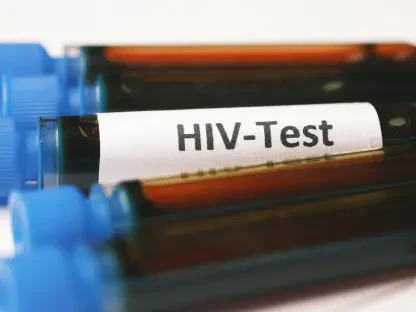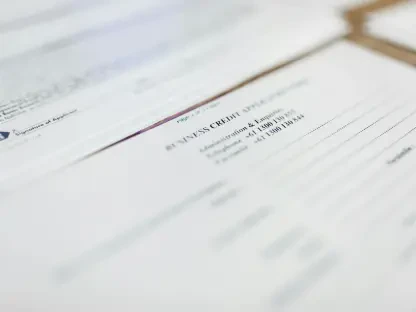Blockchain technology stands at the forefront of a potential revolution in North American healthcare, promising to address some of the most persistent challenges in the industry with its decentralized and secure framework. As healthcare systems grapple with issues like data breaches, inefficient processes, and lack of trust among stakeholders, blockchain emerges as a transformative solution capable of enhancing security, transparency, and patient empowerment. With market projections indicating robust growth from 2025 to 2035, this technology is not just a futuristic concept but a practical tool already gaining traction. This article explores the profound ways blockchain is set to reshape healthcare, delving into its core benefits, integration with other innovations, market dynamics, and the hurdles that must be navigated for widespread adoption. By examining these facets, a clearer picture emerges of how this technology could redefine the future of medical services across the region.
Core Advantages of Blockchain in Healthcare
Securing Data and Empowering Patients
Blockchain’s most immediate and critical impact on healthcare lies in its ability to safeguard sensitive information in an era where cyberattacks are increasingly sophisticated and frequent. By creating immutable records, blockchain ensures that patient data—ranging from medical histories to treatment plans—remains protected from unauthorized access or tampering. This technology establishes a fortified barrier against data breaches, which have plagued healthcare providers for years, costing millions in damages and eroding public trust. Beyond mere protection, blockchain introduces a paradigm shift by allowing patients to have direct control over their health records. Through secure digital platforms, individuals can grant or revoke access to their data, ensuring that privacy and consent are not just ideals but enforceable rights. This empowerment aligns with the growing demand for transparency in medical interactions, fostering a stronger bond of trust between patients and providers.
Another dimension of blockchain’s security advantage is its role in mitigating fraud within healthcare systems, particularly in areas like insurance claims and billing discrepancies. Traditional systems often leave room for manipulation due to centralized databases that can be altered or exploited. Blockchain counters this by offering a transparent ledger where every transaction or data entry is permanently recorded and verifiable by all authorized parties. This not only reduces fraudulent activities but also streamlines audits, saving time and resources for healthcare organizations. Additionally, the patient-centric model enabled by blockchain encourages active participation in care decisions, as individuals can securely share their records with multiple providers without fear of misuse. This seamless access to accurate, up-to-date information can significantly enhance the quality of care, especially in emergency situations where every second counts, highlighting blockchain’s dual role as both a shield and an enabler.
Streamlining Operations and Ensuring Transparency
Blockchain’s potential to drive efficiency in healthcare operations is evident in its application to complex processes such as billing and claims adjudication, which often burden providers with high administrative costs. By automating these tasks through smart contracts—self-executing agreements coded on the blockchain—payments and claims can be processed with minimal human intervention, slashing overhead costs and reducing errors. This automation also curtails instances of fraud, as every transaction is recorded on an unalterable ledger visible to relevant stakeholders. The result is a more fluid system where financial disputes are minimized, allowing healthcare entities to redirect resources toward patient care rather than paperwork. Such advancements are particularly vital in a sector where operational inefficiencies drain billions annually, underscoring blockchain’s value as a cost-saving mechanism.
Equally transformative is blockchain’s impact on supply chain management within healthcare, where transparency is paramount to ensuring the integrity of medical products like pharmaceuticals and devices. Counterfeit drugs pose a significant threat to patient safety, often infiltrating markets due to opaque supply chains. Blockchain addresses this by providing a traceable record of a product’s journey from manufacturer to end user, verifying authenticity at every step. This level of visibility not only combats counterfeits but also builds trust among consumers and regulators, who can be confident in the legitimacy of critical supplies. Hospitals and pharmacies benefit from reduced risks and improved inventory management, as real-time tracking prevents shortages or overstocking. As adoption grows, this application of blockchain could set a new standard for accountability in healthcare logistics, ensuring that patient safety is never compromised by preventable supply chain failures.
Convergence with Cutting-Edge Innovations
Amplifying Capabilities with AI and IoT
The integration of blockchain with artificial intelligence (AI) represents a powerful synergy that could redefine decision-making processes in healthcare by leveraging secure, reliable data for advanced analytics. AI thrives on vast datasets to predict health trends, personalize treatments, and optimize resource allocation, but its effectiveness hinges on data integrity. Blockchain provides an unassailable foundation by ensuring that the information feeding AI algorithms is accurate and untampered, thus enhancing the precision of predictive models. For instance, in chronic disease management, AI can analyze blockchain-secured patient data to forecast complications and recommend preventive measures, ultimately improving outcomes. This combination not only boosts clinical accuracy but also reassures stakeholders that the insights driving medical decisions are based on trustworthy information, paving the way for smarter healthcare systems.
Complementing this is blockchain’s integration with the Internet of Things (IoT), which is increasingly prevalent in medical devices for real-time monitoring and care delivery. IoT-enabled tools, such as wearable health trackers and remote diagnostic equipment, generate continuous streams of data that are vulnerable to interception or manipulation if not properly secured. Blockchain steps in by encrypting and decentralizing this data, ensuring that transmissions between devices and healthcare systems remain confidential and intact. This security is crucial for applications like telemedicine, where patient vitals are shared instantly with providers for timely interventions. Moreover, the tamper-proof nature of blockchain logs allows for a verifiable history of device performance and patient metrics, aiding in both care coordination and regulatory compliance. This fusion of technologies signals a future where healthcare is not only reactive but proactively adaptive to patient needs through secure, connected ecosystems.
Pioneering New Frontiers in Research and Care
Blockchain’s convergence with emerging technologies also opens new avenues for medical research, particularly in the realm of clinical trials where data integrity and participant privacy are non-negotiable. By securely recording trial data on a blockchain, researchers can ensure that results are transparent and free from manipulation, fostering greater credibility in findings that influence drug development and treatment protocols. This transparency is vital for gaining public and regulatory trust, especially in an era of heightened scrutiny over research practices. Furthermore, blockchain enables anonymized data sharing among research institutions, allowing for broader collaboration without compromising participant identities. Such advancements could accelerate the pace of medical breakthroughs, as secure data pools fuel innovation across borders and disciplines.
Beyond research, the integration of blockchain with technologies like AI and IoT enhances personalized medicine by enabling a holistic view of patient health through interconnected, secure data systems. For example, AI can tailor therapies based on genetic profiles and lifestyle data sourced from IoT devices, all safeguarded by blockchain’s robust architecture. This approach ensures that treatments are not only customized but also protected from privacy breaches that could deter patients from sharing sensitive information. Additionally, healthcare providers can use these integrated systems to monitor adherence to treatment plans in real time, adjusting interventions as needed with full confidence in the data’s authenticity. This technological triad promises a shift toward precision care, where every patient benefits from solutions uniquely suited to their needs, backed by a framework that prioritizes security and trust at every level.
Navigating Market Forces and Obstacles
Fostering Growth Through Policy and Competition
A key driver of blockchain adoption in North American healthcare is the supportive policy environment cultivated by governments in the United States and Canada, where digital health initiatives are prioritized through funding and legislative frameworks. Regulatory bodies are increasingly recognizing the potential of blockchain to address systemic inefficiencies, offering grants and pilot programs to encourage its integration into public and private healthcare systems. These efforts lower the barrier to entry for organizations exploring blockchain solutions, creating a fertile ground for innovation. Hospitals and tech firms alike benefit from incentives that offset the substantial initial investments required, while standardized guidelines help align blockchain implementations with existing laws. This governmental backing is a catalyst for scaling blockchain from niche experiments to mainstream applications, shaping a future where digital transformation is synonymous with healthcare progress.
The competitive landscape further accelerates this growth, as a mix of established tech giants and nimble startups vie to define the trajectory of blockchain in healthcare. Major corporations bring scalable, enterprise-level solutions to the table, leveraging their vast resources to integrate blockchain across large hospital networks and insurance frameworks. Meanwhile, smaller innovators focus on specialized applications, such as securing genomic data or enhancing niche aspects of patient care, adding diversity to the market. Strategic partnerships and mergers are commonplace, enabling shared expertise and technology to tackle complex challenges collaboratively. This dynamic environment ensures that innovation is not stifled by monopoly but enriched by varied approaches, driving a robust ecosystem where blockchain solutions evolve rapidly to meet the diverse needs of healthcare stakeholders.
Addressing Barriers to Widespread Implementation
Despite its promise, blockchain faces significant hurdles in achieving widespread adoption within North American healthcare, with high implementation costs standing as a primary obstacle for many organizations. Developing and deploying blockchain systems demands substantial financial investment in infrastructure, training, and integration with existing technologies, often placing it out of reach for smaller providers or underfunded facilities. This economic barrier risks creating a divide where only well-resourced entities can harness blockchain’s benefits, potentially exacerbating disparities in healthcare quality. To counter this, targeted funding mechanisms and cost-sharing models through public-private partnerships are essential to democratize access, ensuring that the transformative power of blockchain is not limited to a privileged few but extends across the entire healthcare spectrum.
Regulatory complexities also pose a formidable challenge, as aligning blockchain solutions with stringent standards like HIPAA in the U.S. requires meticulous planning and legal expertise. These regulations, while crucial for protecting patient rights, can slow down adoption by imposing rigorous compliance demands that vary across jurisdictions. For instance, ensuring data privacy on a decentralized ledger while meeting legal mandates is a technical and bureaucratic tightrope that many organizations struggle to navigate. Overcoming this necessitates close collaboration between tech developers, healthcare providers, and policymakers to craft frameworks that balance innovation with accountability. Additionally, education and advocacy play a vital role in demystifying blockchain for regulators and providers alike, fostering an environment where its adoption is seen as a strategic imperative rather than a risky venture. Only through such concerted efforts can blockchain’s full potential be realized in reshaping healthcare for the better.
Reflecting on Blockchain’s Path Forward
As the journey of blockchain in North American healthcare unfolds, its capacity to address critical pain points like data security and operational inefficiency becomes evident through targeted applications and strategic integrations. The technology proves instrumental in safeguarding patient information and streamlining processes that once bogged down providers with excessive costs and delays. Looking back, the supportive policies and competitive fervor of both industry leaders and startups were pivotal in pushing blockchain from theoretical promise to practical impact. To build on this momentum, stakeholders must now focus on actionable strategies—such as fostering collaborations to offset costs and advocating for clearer regulatory pathways—that ensure blockchain’s benefits reach every corner of the healthcare system. By prioritizing accessibility and innovation in equal measure, the foundation laid in these early stages can support a future where healthcare is not only more secure and efficient but also fundamentally more equitable for all.









